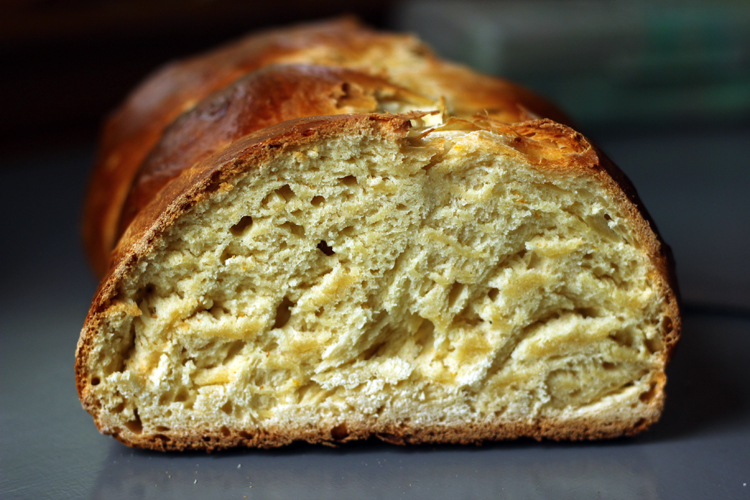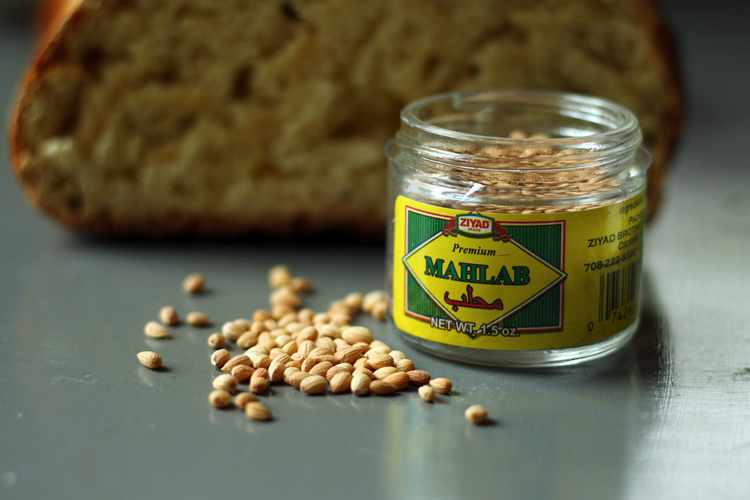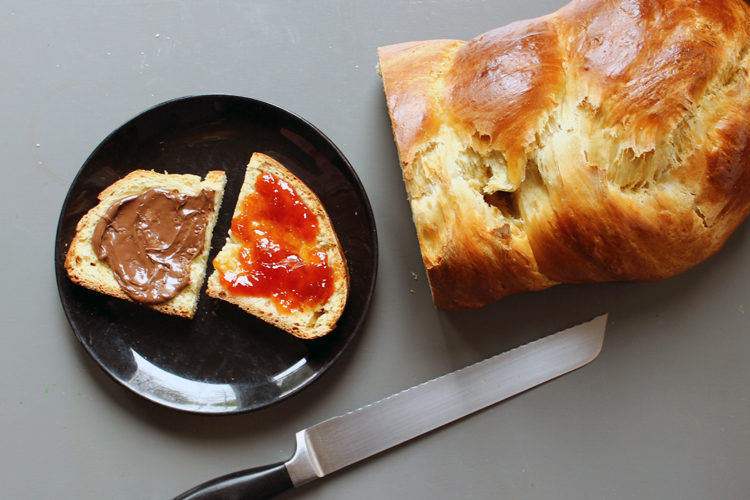Today is Greek Easter. I was lucky enough to have my sister-in-law and her husband visiting from Athens and they made us all the traditional treats. My favorite is tsourki, the traditional Greek Easter bread.
This year, my sister-in-law tried a new recipe for the tsoureki and it was the best we have ever had. It was just sweet enough, moist, aromatic and the ideal flavor. The egg-enriched bread is common in many cultures, each with its own variation. In Greece, the tsoureki is served to break the Lenten fast.
 One of the secrets to my sister-in-law’s success was obtaining the right ingredients, in particular, mahlepi, also known as mahlab. I had never even heard of it before yesterday! Mahlab are the seed kernels from inside a cherry stone from a particular variety of cherry tree. They have a bit of a cherry aroma but have a bitter almond flavor. They are like nothing I’d tried before. We ground them with a mortar and pestle and though only 1 teaspoon was included in the recipe, I could taste a difference from past versions of the traditional Greek bread that didn’t include the mahlab.
One of the secrets to my sister-in-law’s success was obtaining the right ingredients, in particular, mahlepi, also known as mahlab. I had never even heard of it before yesterday! Mahlab are the seed kernels from inside a cherry stone from a particular variety of cherry tree. They have a bit of a cherry aroma but have a bitter almond flavor. They are like nothing I’d tried before. We ground them with a mortar and pestle and though only 1 teaspoon was included in the recipe, I could taste a difference from past versions of the traditional Greek bread that didn’t include the mahlab.
We were able to find mahlab in our local store that has a large ethnic section. If you aren’t as lucky, you can find it online here. Don’t buy already ground spice, it won’t taste the same.
The other aroma and flavors in the tsoureki comes from fresh orange rind, fresh orange juice and cardamom. Butter is also mixed into the dough adding to its richness.
Many Greeks put traditional bright red hard boiled eggs in the bread or on it after baking. The bright red eggs represent the blood of Jesus Christ. Our family makes the eggs but we prefer to eat them alongside the bread and not press them directly into the bread as it spreads the coloring into the bread.
This morning, we enjoyed thick slices of the freshly made tsourki with our favorite toppings. My mother-in-law makes jam from the apricot and plum trees in their yard on Corfu. The apricot jam is a favorite of mine, so deep with flavor it tastes like candy. And to really put our decadence over the top, we always spread a slice with Nutella.
This recipe makes two very large loaves or three normal size loaves. You can cut it in half if you don’t want as much bread. Here are a few tips to help you along the way.
– If you have a stand mixer, use the dough hook for the kneading. This dough is a very stiff dough that that is quite tough to work with.
– When you are adding the flour, keeping going until it is not sticky at all. The dough should not be wet but should have a pliable, shiny, smooth texture. It is very firm.
– Don’t rush the rising. To make a warm, draft-free place, we put our oven on 200 degrees Fahrenheit. Then, we turn it off and put the dough covered inside. Some of the hot air escapes when you put the bowl in so it doesn’t stay at 200.
– Find the right ingredients! The flavor is SO good, especially when you use the freshly ground mahlab, good cardamom and freshly grated orange zest.
Tsoureki – Greek Easter Bread Recipe
Makes 2 very large or 3 large loaves
Ingredients:
6 eggs (whites and yolks separated)
2 cups milk
2 1/2 cups white sugar
1/2 cup of softened butter
1 teaspoon grounded mahlepi (mahlab)
1 teaspoon ground cardamom
1 teaspoon pure vanilla extract
Freshly grated zest and juice of one orange orange
4 1/2 teaspoons yeast (or 2 small packets)
1/2 cup warm water
13 – 14 cups bread flour
1 egg + 2 Tablespoons milk for egg wash to brush on top
Preparation:
Add the yeast to the warm water and stir. Let it sit.
Separate the 6 eggs. Using an electric mixer, mix the egg whites until frothy, not until they are a full meringue. Warm the milk in a sauce pan and stir the sugar until dissolved. Do not scald the milk. Let it cool slightly.
Mix together egg yolks, sweetened milk, mahlepi, cardamom, orange juice, orange zest, vanilla. Add the yeast and combine. Fold in the egg whites. Reserve 1 tablespoon of the butter to cover the bread dough in the next step. Add the flour and butter alternately in 3 portions each continuing to knead for 10 minutes. Add flour until the dough is no longer sticky. It should be quite stiff and a bit shiny.
Make the dough into a ball and cover it with the reserved butter in a bowl. Cover loosely with a kitchen towel and leave it to rise in a warm, draft free place until it is twice as big (45-60 minutes).
Preheat the oven to 350 degrees. Punch down the dough and create a ball. Divide it into 3 portions for 3 loaves or 2 portions for extra large loaves. The bread will be braided. Divide each loaf into 3 separate portions and roll them out into logs. Press them together at the top. Braid the dough and press the pieces together at the bottom.
Put the braids on sheet pans. Cover them and let them rise again for about 40 minutes more until they double in size.
Beat the egg and mix it with 2 tablespoons of milk. Brush the outsides of the bread with the egg wash. Bake in the oven for approximately 50 minutes. The outside will be golden brown and when tapped, the inside will sound hollow. If you want to measure the inside temperature, it should be about 190 degrees when done.
Remove from oven and let cool.

